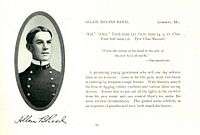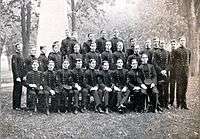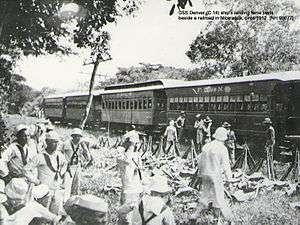Allen B. Reed
| Allen B. Reed | |
|---|---|
| Born |
April 3, 1884 Liberty, Missouri |
| Died |
February 28, 1965 (aged 80) Bethesda, Maryland |
| Place of burial | Arlington National Cemetery |
| Allegiance |
|
| Service/branch |
|
| Years of service | 1904–1941 (37 Years) |
| Rank |
|
| Commands held |
USS Paragua USS Iris USS Susquehanna USS Worden Division 30, Destroyer Squadron 11 Battle Fleet Division 45, Destroyer Squadron 11 Battle Fleet USS New Orleans |
| Battles/wars |
Philippines- Moro Rebellion First Nicaraguan Campaign Mexico Service World War I |
| Awards | Navy Cross |
| Other work |
Todd Shipyards Charleston Naval Shipyard New York Shipbuilding Corporation |

Captain Allen Bevins Reed (April 3, 1884 – February 28, 1965) was a U.S. Naval officer whose 30-year span of ship-commands began on a patrol gunboat fighting pirates and Moro rebels in the Philippines at the turn of the 20th century and ended as the plank owner commanding officer of the newly commissioned heavy cruiser USS New Orleans (CA-32) in the 1930s. In the latter years of his naval career, Reed was attached to the office of the Chief of Naval Operations where his assignments included Director of Fleet Maintenance Division, Assistant to the Chairman of the U.S. Maritime Commission and navy liaison to the Office of Production Management before he went on retired inactive status in 1941, three months before the attack on Pearl Harbor.
Early life and education


Allen Bevins Reed was born in Liberty, Missouri, on April 3, 1884, the oldest of four children of Sheriff James French Reed (1852-1909) and Fannie G. (Wymore) Reed (1857-1936), married on March 28, 1883.[1] He was named for his grandfather, Captain Allen Grigsby Reed (1812-1899). Graduating from Liberty High School in 1900, Allen B. Reed received an appointment to enter the United States Naval Academy at Annapolis, Maryland from Rep. John Dougherty (D-Missouri) of the 3rd congressional district.
Reed entered the Academy on September 22, 1900, as one of 93 fourth class naval cadets,[2] as midshipmen were known until July 1, 1902 when the rank reverted to the traditional "midshipman".[3] During the summers of 1901 and 1902 he made training cruises on the USS Indiana (BB-1) and USS Chesapeake. There were 71 third class naval cadets in 1901-1902,[4] 67 second class midshipmen in 1902-1903[5] and 62 first class midshipmen in 1903-1904.[6] While at Annapolis, Reed was on the track, gymnastics and football teams.[7] Reed's fellow graduates of the Naval Academy class of 1904 included future Admirals William S. "Bull" Halsey, Jr., commander of South Pacific Area and later United States Third Fleet during World War II and Husband E. Kimmel, commander of United States Pacific Fleet at the time of the attack on Pearl Harbor.
Completing his academic studies at the Naval Academy, Reed received his warrant as a passed midshipman. On January 25, 1904 he was detached from Annapolis "to home and ready for sea".[8][9] At that time, passed midshipmen were required to successfully complete two years sea duty before being commissioned as an ensign. On March 21, 1904, Reed reported for duty aboard the school ship USS Mohican.[10] On April 8, 1904, Mohican was assigned as station ship at the Naval Station, Olongapo, Subic Bay, Luzon, Philippines and one month later sailed from Mare Island Naval Shipyard via Honolulu, Guam, and Cavite for her new station, arriving February 4, 1905. Reed served on Mohican variously as W division and signal officer before he was detached on April 17, 1905 to be executive officer of USS Paragua.[11]
U.S. Naval service
Asiatic fleet
In 1905, as a 21-year-old passed midshipman, Reed was given the coveted assignment of second-in-command of a vessel, the 30-man gunboat, USS Paragua, Ensign Charles S. Kerrick, commanding.[12] Paragua was part of the Philippine Squadron of the Asiatic Fleet[13] that along with other ships in the "mosquito fleet" of mostly seized ex-Spanish gunboats and steam yachts, patrolled the Philippine Islands primarily south of Mindanao in the Sulu Archipelago to intercept pirates, gunrunners, slave-traders and support U.S. Army and local Philippine Constabulary ground forces during the Moro Rebellion of 1899-1913.
On December 14, 1906, Reed detached from Paragua to the protected cruiser USS Baltimore (C-3), cruising Asiatic, Philippine and Australian waters before returning to the New York Navy Yard on April 26, 1907.[14][15]
Pacific fleet
Reed was assigned to the protected cruiser USS Charleston (C-22) of the Pacific Fleet Second Squadron Third Division, from June 10, 1907 to April 18, 1908 as W & D division officer and senior assistant engineering officer.[16][17] Charleston sailed along the west coast from Mexico to British Columbia on exercises and fleet maneuvers until entering Mare Island Naval Shipyard in March 1908 to prepare for transfer to the Asiatic Fleet.
Ensign Reed detached from Charleston on April 18, 1908 to the protected cruiser USS Albany (CL-23), of the Pacific Fleet Second Squadron Fourth Division, as senior engineer, reporting for duty on April 19, 1908 at Mare Island where Albany was berthed.[18]
Reed was promoted to lieutenant on February 2, 1909, bypassing lieutenant (junior grade). He was detailed to escort visiting Imperial Japanese Navy Captain Takeshita Isamu, commanding the armored cruiser Izumo, that had set out from Sasebo, Japan on September 20, 1909, to participate in the dedication ceremonies for the new Santa Monica Municipal Pier which coincided with California Admission Day.[19] Visitors toured the warships and four companies of bluejackets, two from each cruiser, marched in a parade from the Santa Monica, California city hall to the new pier.[20]
Mare island
When Albany returned to Mare Island on April 28, 1910,[21] Lieutenant Reed detached from Albany the next day to Mare Island Naval Shipyard, where he served from May 4, 1910 to June 25, 1912 as assistant inspection officer.[22]
While at Mare Island, Reed had temporary duty assignments from March 8–11, 1911 on USS Yorktown and on USS Cincinnati (C-7) from October 7–11, 1911 as engineering officer. As assistant inspection officer, he was a member of the Naval Board of Inquiry that convened to investigate the publicized fraud scandal involving naval Paymaster Arthur M. Pippin. Pippin, his pay clerk and chief yeoman on the receiving ship USS Independence, among other schemes, were suspected of withholding and embezzling uniforms bought by recruits and selling these and other supplies to civilian merchants.[23][24][25] The board of inquiry found cause to court-martial Pippin and his two associates. They were ultimately convicted and Pippin and his pay clerk received sentences of seven and three years respectively, hard labor at San Quentin, "the severest punishment ordered by a naval court-martial in many years."[26][27]
Nicaragua

During the United States occupation of Nicaragua, on June 25, 1912, Lieutenant Reed was detached from Mare Island to the protected cruiser, USS Denver (CL-16), as executive officer.[28]
On July 9, his orders were changed to duty as navigator.[29] Denver was recommissioned on July 25, 1912 at Mare Island for service with the Pacific Fleet cruising the west coast from San Francisco to Central America to protect American citizens and property.
On August 29, 1912, a landing force of 120 men under the command of Lt. Reed was landed from Denver at Corinto to protect the railway line running from Corinto to Managua and then south to Granada on the north shore of Lake Nicaragua. This landing party reembarked aboard ship October 24 and 25th, 1912.
Pacific Torpedo Flotilla
Reed's next assignment after being detached from Denver on May 23, 1913 at San Diego, was to the Pacific Torpedo Flotilla tender, USS Iris, as executive officer and navigator.[30][31] One of his crew, John Samuels, a 21-year old sailor who had recently "shipped over for another hitch" (re-enlisted) was heir to a $2 million estate and the richest enlisted man in the navy, but preferred the sea and the $20 a month he would earn for the next four years to the "joys of living ashore".[32] Iris was based at San Diego and serviced the Pacific Fleet torpedo ships and submarines.
Panama
Reed detached from Iris on June 3, 1915. He had requested transfer to the recently opened Panama Canal (1914) where he served from July 8, 1915 to August 1, 1917 as only the second Captain of the Port at Balboa, the Pacific canal terminus, replacing Commander Henry V. Butler.[33][34][35] While serving as Port Captain at Balboa, Reed was promoted to lieutenant commander on August 29, 1916.
World War I
Temporarily promoted to commander on February 1, 1918[36] during World War I, Reed served first as executive officer and later as commanding officer of the USS Susquehanna (ID-3016), the former German liner, SS Rhein, a troop transport that made seven transatlantic crossings carrying over 18,000 American troops to Europe and bringing over 15,000 troops home after the Armistice. Reed was awarded the Navy Cross in 1920 "for distinguished service in the line of his profession as commanding officer of the USS Susquehanna, engaged in the important, exacting and hazardous duty of transporting and escorting troops and supplies to European ports through waters infested with enemy submarines and mines."[37]
Washington D.C.
Following World War I, he was assigned to the Bureau of Steam Engineering in Washington, D.C. and permanently promoted to commander on June 3, 1921. In 1923-24 he served as executive officer on the battleship USS Florida (BB-30). From June 1924 through July 1925, he was assigned to United States Naval Forces Europe and commanded the Clemson-class destroyer USS Worden (DD-288) which visited numerous ports in the Mediterranean Ocean before returning to the New York Naval Yard in July 1925. Thereafter, Reed was assigned to matriculate at the Naval War College in Newport, Rhode Island for a year. He was assigned to the Ships' Movement Division of the office of the Chief of Naval Operations in Washington, D.C. from June 1926 through July 1928 and promoted to captain on March 16, 1927.
From August 1928 through June 1929 he commanded Division 30, Destroyer Squadron 11, Battle Fleet from the flagship USS McCawley (DD-276) home-port Puget Sound Navy Yard in Bremerton, Washington and from July 1929 through May 1930 he commanded Division 45, Destroyer Squadron 11 from the USS Preble (DD-345) home-port of Naval Base San Diego. Returning to Washington, D.C. in June 1930, he was assigned to the Material Division of the office of the Chief of Naval Operations.
USS New Orleans
The USS New Orleans (CA-32) was launched on April 12, 1933 at the Brooklyn Navy Yard, with Reed selected as the first commanding officer of the 876-man heavy cruiser. Orleans was a lead ship in a class of seven "treaty cruisers", that collectively saw extensive service in all major engagements in the Pacific theater during World War II.
New Orleans was commissioned on February 15, 1934 at the Brooklyn Navy Yard. Under Captain Reed's command that ended on August 30, 1935, USS New Orleans made a shakedown Transatlantic crossing to Northern Europe and Scandinavia in May and June 1934, returning to New York on June 28, 1934. On July 5, New Orleans sailed to rendezvous with USS Houston (CA-30), carrying President Franklin Delano Roosevelt, for a nearly 12,000 nmi. cruise through the Panama Canal to Hawaii and an exercise with the United States Airship Macon and her aircraft off the California coast. Among New Orlean's junior officer plankowners under Captain Reed's command in 1934 were Ensign E.L. Jahncke, Jr., son of the Assistant Secretary of the Navy, and Ensign T.H. Moorer, who as Admiral Thomas H. Moorer was Chief of Naval Operations (CNO) from 1967-1970 and Chairman of the Joint Chiefs of Staff from 1970-1974.
World War II

After his command of USS New Orleans ended, Captain Reed was ordered back to Washington to serve at the Office of the Chief of Naval Operations as Director of Fleet Maintenance Division[38] and on the Joint Economy Board between the Army and Navy[39] Later, he was appointed Chairman of the Executive Committee of the Army and Navy Munitions Board until 1939. Transferred from the active to retired list on June 30, 1939, he nevertheless continued on active duty for two more years. In 1940 and 1941 he was assistant to the Chairman of the U.S. Maritime Commission, Admiral Emory S. Land and Navy liaison to the Office of Production Management of the Council of National Defense. After 37 years of service and the attack on Pearl Harbor still three months in the future, Captain Reed transferred to the inactive list on September 5, 1941.
During World War II, he worked as an executive with shipbuilding firms in New York, Texas and South Carolina, before retiring in 1946. On September 6, 1944, his wife, Bess M. Reed, sponsored the USS Torsk (SS-423) at its launch from the Portsmouth (Maine) Navy Yard. Torsk was a Tench class submarine that was credited with sinking the last Japanese warship during World War II on August 14, 1945. Torsk served until 1971 and today it is a museum ship moored at Pier Three of Baltimore's Inner Harbor at the Baltimore Maritime Museum adjacent to the National Aquarium.
Personal life
Lieutenant Reed married the former Bessie Moorhead of Omaha, Nebraska on September 25, 1909 at the home of the her parents in Omaha and returned to San Francisco on October 10.[40][41] During his retirement, Captain Reed was a resident of Washington, DC and lived on Woodley Rd. NW where he and his wife lived from 1930 until his death in 1965
Dates of rank
 United States Naval Academy Midshipman – Class of 1904
United States Naval Academy Midshipman – Class of 1904
| Ensign | Lieutenant, Junior Grade | Lieutenant | Lieutenant Commander | Commander | Captain |
|---|---|---|---|---|---|
| O-1 | O-2 | O-3 | O-4 | O-5 | O-6 |
 |
 |
 |
 |
 |
 |
| February 2, 1906 | February 2, 1909 | February 2, 1909 | August 29, 1916 | February 1, 1918 | March 16, 1927 |
Reed never held the rank of Lieutenant Junior Grade, as he was appointed a full Lieutenant after three years of service as an Ensign. For administrative reasons, Reed's naval record states he was promoted to the rank of Lieutenant (junior grade) and Lieutenant on the same day.
Decorations and awards
|
| Navy Cross | Philippine Campaign Medal | First Nicaraguan Campaign Medal |
| Mexican Service Medal | World War I Victory Medal with Transport Clasp | American Defense Medal |
References
- Notes
- ↑ The Liberty Tribune, March 30, 1883
- ↑ Register of Commissioned and Warrant Officers of the Navy of the United States and Marine Corps, January 1901, p. 86
- ↑ A Brief History of the United States Naval Academy
- ↑ Register of Commissioned and Warrant Officers of the Navy of the United States and Marine Corps, January 1902, p. 87
- ↑ Register of Commissioned and Warrant Officers of the Navy of the United States and Marine Corps, January 1903, p. 91
- ↑ Register of Commissioned and Warrant Officers of the Navy of the United States and Marine Corps, January 1904, p. 98
- ↑ The Lucky Bag, 1904, p. 69
- ↑ National Archives and Records Administration, "Transcript of Service of Allen Bevins Reed, Commander (T) USN", March 20, 1920
- ↑ N.Y. Times, April 23, 1903
- ↑ Register of Commissioned and Warrant Officers of the Navy of the United States and Marine Corps, January 1905, p. 48
- ↑ Register of Commissioned and Warrant Officers of the Navy of the United States and Marine Corps, January 1906, pp. 42
- ↑ Register of Commissioned and Warrant Officers of the Navy of the United States and Marine Corps, January 1906, pp. 188
- ↑ Annual Report of the Secretary of the Navy, 1905, p. 388
- ↑ New York Times, "Baltimore Home from Far Off Seas", April 27, 1907
- ↑ Register of Commissioned and Warrant Officers of the Navy of the United States and Marine Corps, January 1907, p. 200
- ↑ The Times-Dispatch: Richmond, VA, June 12, 1907
- ↑ Register of Commissioned and Warrant Officers of the Navy of the United States and Marine Corps, January 1908, p. 205
- ↑ Register of Commissioned and Warrant Officers of the Navy of the United States and Marine Corps, January 1908, p. 206
- ↑ The San Francisco Call, October 13, 1909
- ↑ The Los Angeles Herald, September 10, 1909
- ↑ The San Francisco Call, April 29, 1910
- ↑ Register of Commissioned and Warrant Officers of the Navy of the United States and Marine Corps, January 1911, p. 244-245
- ↑ The Hawaiian Star, May 3, 1911, p. 1
- ↑ The San Francisco Call, April 21, 1911, p. 5
- ↑ The San Francisco Call, April 25, 1911, p. 5
- ↑ The Washington Times, November 3, 1911, p. 1
- ↑ The New York Daily Tribune, November 4, 1911
- ↑ The Washington Times, June 26, 1912
- ↑ Register of Commissioned and Warrant Officers of the Navy of the United States and Marine Corps, January 1913, pp. 31, 62
- ↑ The Washington Times, May 26, 1913
- ↑ Register of Commissioned and Warrant Officers of the Navy of the United States and Marine Corps, January 1914, p. 256
- ↑ Honolulu Star Bulletin, May 22, 1913
- ↑ Honolulu Star Bulletin, July 10, 1915
- ↑ The Washington Times, June 11, 1915
- ↑ Register of Commissioned and Warrant Officers of the Navy of the United States and Marine Corps, January 1917, p. 334
- ↑ The Official U.S. Bulletin, December 26, 1917, p.7
- ↑ Military Times Hall of Valor, Navy Cross Recipients
- ↑ Official Register of the United States, 1938
- ↑ Official Register of the United States, 1937
- ↑ The San Francisco Call, October 8, 1909
- ↑ Omaha Daily Bee, August 26, 1914